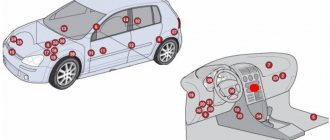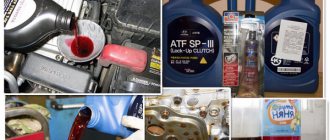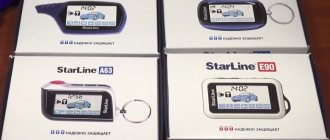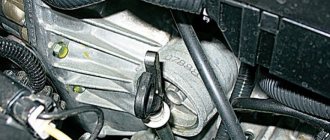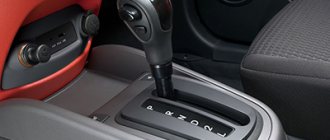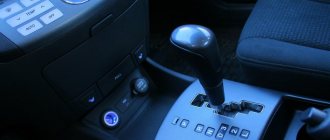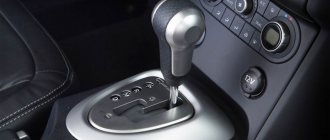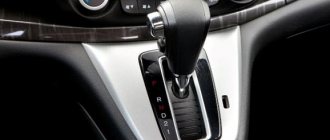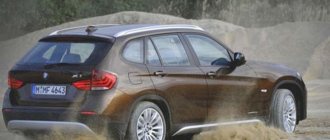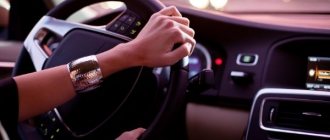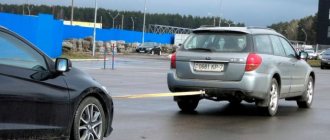Manufacturer's Warranties
Robot? variable speed drive? hydromechanics?
Volkswagen provides a five-year warranty for the entire DSG transmission, with a mileage warranty of 150,000 km.
In accordance with the terms of the obligations, the automaker promises to eliminate, by repairing or replacing the DSG, any defects that arise during the warranty period.
The warranty covers mechanical and electrical components if the damage is directly attributable to manufacturing defects.
The manufacturer refuses to correct faults at its own expense when the car was not operated properly, was not serviced on time, if changes were made to the design of the car (for example, engine chip tuning was performed).
Which gearbox is better, automatic or variator: what are the differences, which is more reliable, pros and cons
Automatic transmission and variator (sometimes abbreviated CVT) is a device for converting engine torque and transmitting it to the drive wheels. Both mechanisms perform the same function. But it should be noted: the principle of their work is similar, but has significant differences.
The automatic transmission is a little simpler. Repairs are somewhat cheaper. Before purchasing, you need to contact specialists - they will explain the differences between different boxes in simple language.
The main difference between a CVT and an automatic is that switching occurs steplessly. Regulation is carried out within a certain range specified by the designers. There are 3 main types of variators:
What do automatic transmissions and DSG have in common?
- Automation . Both transmissions are automatic and the driver does not need to be distracted by squeezing the clutch, shifting the lever, or adjusting the gas pedal. This is especially important for drivers who have just received a driver's license and have not yet acquired sufficient skills in driving a manual transmission.
- When the transmission is in good condition, switching occurs smoothly, comfortably, without jerking.
- The modes and their letter designations are identical.
DSG gearbox
Robotic transmission - this is what the DSG gearbox is usually called. The mechanism is similar to a conventional manual transmission, only the gear shift function is performed automatically.
A distinctive feature of this type is the presence of two clutches . Each of them is responsible for its own series of steps – even and odd. Starting in first gear, one disc is closed, while the second is ready to shift to the next gear. When the required engine speed and speed are reached, the first disk opens and the second closes, shifting the box to the next gear. When the speed decreases, the process occurs in the reverse order.
Read also: Shea butter in cream and face masks
Thanks to this system, torque is transmitted as smoothly as possible and without loss of power, which significantly reduces fuel consumption .
Reviews
Konstantin, Moscow, 25 years old: Purchased a 2022 Nissan Qashqai with an automatic transmission. The impressions are positive, there are no problems. I constantly drive at speeds over 150 km/h outside the city. Many people blame the fragility of the transmission. I am completely satisfied with the purchase. Perhaps it's a matter of low mileage.
Victor, St. Petersburg, 29 years old: I bought a Nissan Teana with a CVT – 2015. After just a few thousand kilometers, a major overhaul was required. The cost of the chain was 30 thousand rubles. Work, other parts - another 35 thousand rubles. I operated the car carefully and did not drive it when it was cold. Perhaps the previous owner lied about the mileage and screwed it up. At the time of purchase, the speedometer showed only 120 thousand km.
Vitaly, Voronezh, 27 years old: Acquired a Skoda Octavia 2 with a DSG robotic gearbox in 2022. Very smooth ride, soft acceleration. I covered 100 thousand km in a year. Work on the chassis and transmission is only routine. There are no problems. Very pleased with the purchase!
The classic torque converter box is the most common automatic transmission used in cars. Its first samples began to be installed back in the 20s of the last century, but it became full-fledged only closer to the middle of the twentieth century, when all three main components were combined into a single mechanism. These main components are: torque converter, planetary gearbox, hydraulic control unit.
In such an automatic machine there is no rigid clutch, and torque is transmitted thanks to the circulation of oil inside the torque converter. The gears are switched using planetary gears in the box, and the control function is performed by a hydraulic unit.
The popularity of this type is due to its sufficient reliability and maintainability
The main attention should be paid to the quality of the oil and timely maintenance of the torque converter
On average, modern automatic transmissions have from 4 to 6 steps. The control includes the main modes:
- "D" - Movement.
- “P” – Parking. Used for long-term parking. The vehicle cannot be moved.
- “R” – Reverse.
- “N” – Neutral. The vehicle can be moved. Used for short stops or for towing.
- “L” – Driving in a lower gear. Used in difficult conditions where engine speed is important.
One of the significant disadvantages of this type is the price. Due to the complexity of the design, the cost of the box is quite high, which entails an increase in the price of the car. It is also worth noting that such a transmission is quite heavy and adds an additional 20 - 30 kilograms of weight to the car. This negatively affects dynamic performance and fuel consumption.
Automatic transmission, CVT, robot - what's the difference?
Today, automatic transmissions are being installed in an increasing number of new cars. And on some cars, for example, only an automatic transmission is installed, and the buyer is not even offered a manual option. Even before buying a car, it is useful to know what automatic transmissions are and what their differences are.
Today there are three types of “automatic machines”
— “ Normal ” (torque converter),
- Variable speed drive
— Robotic (robot).
It is important to know the differences between them not only when buying a new car, but also a used one - to an ignorant buyer, a dishonest seller can easily pass off a CVT or “robot” as a classic “automatic”. So let's find out what the difference is between them and which gearbox is better to choose? Let's start with a regular machine.
Which type is best suited for whom?
Automation is widely popular among women. In this, perhaps, both types of transmissions are not inferior to each other. But it is also important to consider operating conditions. Due to its design, the automatic transmission is suitable for urban conditions. Although the automatic transmission has higher consumption, in traffic jams the DSG is much more susceptible to wear.
The robotic gearbox, thanks to its efficiency and dynamic qualities, is perfect for country trips.
The financial capabilities of the buyer play a significant role. Cars with a classic automatic transmission are more expensive. Therefore, if you don’t have the funds to buy a car with an automatic transmission, but still want to drive an automatic, a car with a DSG gearbox will be an excellent solution.
Auto and motorcycleComment
Automatic transmission or torque converter
This is a classic version of an automatic transmission. Most often among car enthusiasts the question arises regarding which gearbox will be better: automatic or conventional manual. And it’s difficult to give an answer, because not everything is so simple. Having looked at the strengths and weaknesses of a manual transmission, you also need to look at the characteristics of an automatic transmission.
Automatic transmission cross-section
A classic automatic transmission operates on the basis of a torque converter. This is a special unit that switches planetary gears. As for the torque converter itself, it plays the role of a clutch in the structure of the automatic transmission, thereby replacing the need for the driver to depress this pedal and change gears manually, as happens with a manual transmission.
The system is quite complex, but it makes it possible to switch gears automatically. Moreover, the electronics does this at the optimal moment, taking into account the load and driving conditions of the vehicle.
A drawback is the need to change gear oil more frequently. But this is far from the most difficult procedure that you can do yourself. Modern and high-quality automatic transmissions prove that they can serve for a long time and reliably, sometimes eclipsing even old proven manual transmissions in terms of service life and resource.
Traditional automatic transmissions have several main advantages.
Service life or resource. The classic machine works confidently, efficiently and does not require complex maintenance or regular repairs. For a modern automatic transmission, a mileage of 400-500 thousand kilometers is not the limit. The car can travel such a distance if the box is maintained in accordance with the regulations and high-quality consumables are used
The main attention should be paid to the quality of ATF lubricant, that is, automatic transmission oil. Comfort level. Gear shifting is carried out not only almost imperceptibly, but also without driver participation
He doesn’t need to constantly pull the handle, squeeze the clutch, or dose the gas correctly so that the car doesn’t suddenly stall when starting or during a maneuver. Despite the emergence of new subcategories of automatic machines, the classic torque converter is still at a high level in terms of comfort. Simplicity of the device. Yes, the system is more complicated than in the case of mechanics. But not so much as to make independent maintenance or repair impossible. Many motorists successfully maintain automatic transmissions on their own, saving significant money. Resistance to loads. This is the prerogative of newer automatic transmissions, which provide the ability to automatically control very powerful engines. Even in extreme conditions, an automatic transmission often behaves better than a manual transmission. The driver is focused on the road and overcoming obstacles, without being distracted by the gearbox selector. Suitability for repair. Automatic transmissions are definitely repairable. They have typical faults, but all of them have been studied a long time ago, so repairing a classic torque converter will not cost much. This is more expensive than a manual transmission, but significantly cheaper compared to other types of automatic transmissions.
Over time, given the progress of automatic transmissions and the emergence of new varieties, it is already relevant to ask what is better: an automatic or robotic gearbox.
This is due to the fact that the classic machine is gradually losing its relevance. This can be explained by increased environmental requirements and the need to reduce fuel consumption as much as possible. Plus, the creation of automatic transmissions remains expensive, while other alternative technologies are actively becoming cheaper.
Many auto experts are confident that the classic automatic machine will soon cease to exist. And its place will be taken by CVT and robotic gearboxes. Whether this will actually happen or not, time will tell.
Existing versions of DSG boxes
For the first few years, starting in 2003, the DSG-6 gearbox, which received the factory designation DQ250, was only available in conjunction with a transversely mounted engine under the hood, and the cars were equipped with front-wheel drive or all-wheel drive with a Haldex clutch, double wet » clutch (Wet Clutch).
DQ250
This transmission from the Volkswagen concern could be considered the only version that has six gears, but there is also a DQ400e model used in hybrid cars, for example, on the Skoda Superb Mk4 and Volkswagen Golf GTE.
Since the end of 2007, the Volkswagen automaker began equipping its cars with a preselective 7-speed DQ200 robot with a “dry” clutch (Dry Clutch).
The unit is designed to work with engines with a volume of 1.0 to 1.9 liters, mounted transversely, with a maximum torque of up to 250 Newton meters (models VW Polo/Golf/Caddy/Touran/Passat, Skoda Fabia/Octavia/Jetta). There is also a DSG-7 version (DQ200e) with the same type of clutch used on the Jetta Hybrid with the 1.4 TSI power unit.
All other robotic gearboxes produced by VW today come only with Wet Clutch, and all are seven-speed, but can be of different types depending on the engine location.
What other manual transmission models are there from Volkswagen (seven stages, “wet” clutch, for transversely mounted internal combustion engines):
- DQ500 - produced since 2009, mainly found on the Volkswagen Transporter, but can also be installed on Passat B8 (BiTDI), Multivan T5/T6, Tiguan, Audi TT RS and RS3;
- DQ380 - produced since 2014, used on Audi S3 and VW Golf-7 cars, widely distributed in China, in fact, it is a smaller version of DQ500 (VW Golf-7 GTI, Skoda Octavia-3, Octavia RS, Skoda Superb -3, Audi S3);
- DQ381 - exists since 2022, is an improved version of the DQ380, used on many cars built on the MQB platform. The DQ381-7A modification has been developed for all-wheel drive vehicles, and DQ381-7F for front-wheel drive vehicles.
Also, at the moment, there are three types of 7-speed “pre-selective” DSGs, designed to work with engines with a longitudinal arrangement:
- DL382 – start of production: 2015, found on Volkswagen Phideon, as well as on Audi A4 / A5 / A6 / Q5. At first, the gearbox was designed for a torque of up to 400 N*m, and from 2022 it began to be installed on the Audi A6/A7 in the 4K body with a torque rating of up to 500 N*m. There are two modifications: for 4WD – DL382-7Q, for 2WD – DL382-7F;
- DL800 – produced since 2015, used infrequently, the transmission can be found on the second generation Audi R8;
- DL501 (Audi S-tronic) – produced since 2008, installed on Audi Q5-Q7, RS5-RS6, A6-A7, A4 Allroad, A5 Cabriolet, designed for torque up to 600 N*m.
In the line of Volkswagen robotic gearboxes there is one not quite typical model - this is the 10-speed “robot” DQ511, which is similar in its mechanics to the DQ511.
VW Group Director Martin Winterkorn first announced the plan to release this transmission in 2013; according to the calculations of the German automaker, the transmissions were supposed to help reduce fuel consumption by up to 15%. But the gearbox never appeared in the production version; its use was abandoned in 2022.
How to determine the transmission: DSG or automatic
As you know, today automakers offer consumers a large number of automatic transmissions, taking into account the constantly growing demand for gearboxes of this type. In this case, the automatic transmission can be represented not only by a “classic” hydromechanical automatic transmission, but also by a robot, a variator, and also a preselective robotic gearbox with two clutches.
How to distinguish a car with an automatic transmission from a car with a manual transmission
Repairing boxes is frighteningly expensive. But there are simple rules of operation that help defer large financial expenses. Eliminate sporty driving style, slipping, overheating of the box, and then the problem of how to distinguish a DSG from an automatic on a Jetta will not be so relevant.
By VIN code
The type of gearbox can be determined by a unique 17-digit code that manufacturers began assigning to cars in 1980. Exact information about equipment, engines and transmissions cannot be changed.
The data encrypted in the VIN code will help when buying a car secondhand: the future owner will find out whether he really took what he intended. The code sticker is located under the windshield on the driver's side.
According to the documentation
A technical passport is attached to each vehicle. Based on the VW Jetta documents, it is not difficult to determine whether the car is equipped with an automatic transmission or a DSG. But you can dispel suspicions that the box does not correspond to what is stated in the technical papers by looking under the hood.
Here at the gearbox you will find a metal black cover that looks like a pan. It covers the mechatronics of the DSG box. On cars with classic AT there is no such cover.
By behavior on the road
This will require a test drive. There are two pedals under your feet - it is clear that in front of you is one of the automatic transmissions.
If this is a working classic automatic transmission, gear shifts will be smooth and imperceptible, and the engine sound will be smooth. Watch the tachometer as the speed rises and falls as you change gears.
Robot or automatic on the Volkswagen Jetta?
The robot will reveal itself with noticeable, sometimes sharp gear changes. In a DSG with two clutches, these sensations are somewhat leveled out, but an experienced driver will immediately feel the “mechanical” component.
Main problems of DSG
Let us immediately note that today a fairly large number of drivers operate cars with DSG-6 or DSG-7, both “wet” and “dry”. However, among the most common shortcomings are frequent problems with “dry” versions. We can highlight:
- Jerks and jerks when changing gears, especially during active acceleration and upshifts, although there are roars when downshifting. The reason is that dry clutch discs engage abruptly. It feels like the driver of a car with a manual transmission is throwing the clutch pedal instead of releasing it smoothly;
- In this case, there are several reasons, but often the clutch becomes the source of noise. However, situations have also been noted where the DSG makes noise during operation, but continues to work properly for 30-40 thousand km. and more.
- Noticeable loss of traction when accelerating. This indicates that the clutch discs are not able to engage normally, they begin to “slip”, which leads to loss of traction or failure when pressing the gas. Please note that this is dangerous, since this malfunction may appear during overtaking or active maneuvering in traffic.
As you can see, the main problems are related to the dry clutch of the DSG. It is noteworthy that the clutch itself (clutch package), subject to a number of operating conditions, is a reliable design, but problems still often arise due to the fault of the transmission control unit and its software.
In other words, the “brains” of the DSG, better known as mechatronics (mechatronic module), are to blame. This device controls the operation of the entire box and clutch. You can also highlight oxidation of contacts, problems with wiring, contamination of sensors and malfunctions, rapid wear of shaft bearings, clutch release forks and a number of other DSG problems.
